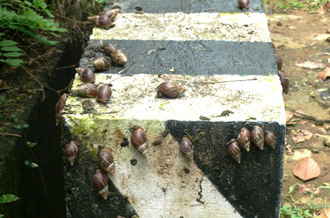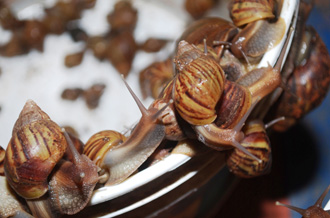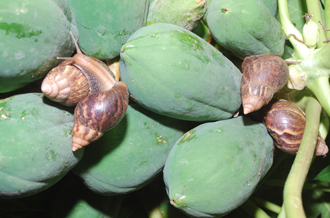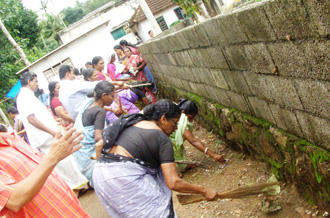Giant snails make rapid inroads into India
Kerala in the south and some other states reel from invasion of mollusk from East Africa, exacting heavy toll on crops.

The day he spotted his first Giant African Snail is vividly etched in CK Chandran’s memory.
Chandran, who works in a government office in Kasargod, in the south Indian state of Kerala, was on his way to work in June, 2011.
Keep reading
list of 4 itemsLost Futures
Photos: Greek valley that became a lake stirs drought debate
Botswana threatens to send 20,000 elephants to Germany
“It looked like a small mammal crossing the road,” he recounts. On closer inspection, he realised it was a snail, and a very large one at that.
In the days that followed, he witnessed a surreal invasion of his home and his neighbourhood, straight out of a Hollywood horror bug flick.
“Not hundreds but thousands,” he says of these snails that were everywhere.
In his garden, the slimy creatures had invaded his papaya, banana and coconut trees severely; they were feeding on all of his vegetable and herb gardens, eating away at the leaves insatiably.
“Even ornamental plants were not spared,” he laments.
Chandran’s town is not the only location in the southern state that the snails have spread to.
While few stories of infestations were heard as early as 2005, by 2011 it was clear that the incursion was widespread.
Today, 10 of the state’s 14 districts are infested and the state has 59 different pockets of snail populations.
Following one nightmarish snail incursion in the hilly town of Konni in 2011, scientists from the Kerala Forest Research Institute (KFRI) sent out advertisements in the media encouraging people to report the snail’s presence.
Mollusk Invasion
Maneetha TK, a KFRI researcher has heard and seen countless “horror tales” from all over the state since then.
People cannot walk at night without the sound of snails being crushed under their feet, she says.
The nocturnal omnipresence of snails is but common: people find them in scarily large numbers in porches, kitchens, bathrooms, inner walls of wells, water pipes, roads; almost anywhere they can make their way to.
 |
| The snails are found in scarily large numbers in porches, kitchens, bathrooms, inner walls of wells, water pipes, roads; almost anywhere they can make their way to [Maneetha TK] |
The snails leave a mucus trail causing nausea, and bodily contact with them can result in itching.
They are also a vector of a roundworm responsible for eosinophilic meningitis in humans if eaten or handled with bare hands.
“In some places, people are vacating from the snail-infested region due to the mass entry of snails into their houses,” informs Maneetha.
They also feed on walls built around homes in order to get calcium, essential to build their shells, from the lime-coated painting.
“Crumbling of compound walls due to their nibbling and gnawing has also been reported,” she adds.
An invasive species
The Giant African Snail, Achatina fulica, a native of East Africa, is the largest land snail in the world. It is among the 100 most invasive species in the world.
Growing to a length of 19cm, it can weigh as much as 750gm. It thrives in moist conditions and is active in Kerala throughout the year, except in the short year end of winter.
Climatic conditions and ample pathways facilitated through human transport have been conducive for the snail population to spread in Kerala.
Kerala’s generous monsoons make 60 to 65% of its area conducive for the snail to thrive in, says TV Sajeev, an alien invasive species expert from KFRI.
 |
| The snails leave a mucus trail causing nausea, and bodily contact with them can result in itching [Maneetha TK] |
But climate is not enough in itself; it is multiple introductions of the snails brought in several times through transport that has resulted in a robust snail population.
“The probability of their survival increases,” he explains.
The lack of internal quarantine led to newer pockets of populations all over the state.
Being a hermaphrodite, one egg-laden snail transported to a new location is enough to start a fresh population, explains J Jayaraj, Professor of Entomology, Agricultural College and Research Institute, Madurai.
“It lays as many as 1200 eggs a year ensuring a huge population spurt,” Jayaraj said.
Tackling the damage
The Giant African Snail feeds on over 500 species of plants and this voracious appetite spells destruction for agriculture.
In Kerala, where the majority have homestead gardens, this means having to depend on market produce for fruits and vegetables and loss of cash crops.
Researcher M Jayashankar from Bangalore’s Indian Institute of Horticultural Research (IIHR) has studied the Giant African Snail and its impact on agriculture since 2005.
Cereals, most vegetables – including tomato, chilis, beans, amaranthus, eggplant, okra, cucumber, French beans, beetroot, yam, cauliflower, cabbage, sweet potato, drumstick, peas, turmeric and ginger, fruits and ornamental plants – are all vulnerable for attack by these foraging mollusks, he explains.
 |
| The snails impact habitats by devouring native plants and competing with indigenous snail species [Maneetha TK] |
“Vegetables are easier to nibble on as they are softer. Papaya and cabbage are snail favourites,” he says.
“They also damage plantation crops such as coffee, areca nut, rubber, vanilla, pepper, even coconut by feeding on seedlings or buds. I have seen farmers losing their entire nurseries in a single night.”
These snails impact habitats by devouring native plants and competing with indigenous snail species.
Snail’s second coming in Kerala
The first recording of the Giant African Snail infestation in Kerala was in 1955 from Palakkad district when a researcher brought a specimen for study.
Sajeev guesses that the first occurrence could have been of a much smaller scale and died off.
But the gateway for the second series of recent invasions has been the Willingdon Island, Cochin port. “The snails entered Kerala with the timber imports from Burma,” he points out.
With the timber the snails travelled all over the state. In Willingdon Island itself, the infestation was so severe that people had to abandon their homes.
What also works for these creatures is that they can hibernate when the conditions are too dry and cold to resurface later.
 |
| Some methods employed against the snails include throwing them on hard surfaces to crush their shells, drowning them in salt water, or use of molluscicides [Maneetha TK] |
Balasubramanium, a rubber farmer from Nenmara, Palakkad says his usual pest control method was sprinkling salt on the mollusks causing them to rot and throwing them into a nearby gutter.
Other methods employed include throwing the snails on hard surfaces to crush their shells, drowning them in salt water, sprinkling salt and lime mixture, salt and bleaching powder mixture or use of molluscicides daily.
Sajeev says that use of chemicals such as metaldehyde brought new problems, including pollution of water bodies.
The KFRI after a series of experiments recommends first attracting the snails with vegetable waste and then a point application of TDCS (Tobacco Decoction and Copper Sulphate) mixture to destroy the snails.
Greater awareness, snail eradication drives, and vigilance when transporting goods from infested areas have meant that people are now better prepared.
The KFRI also runs a prediction model to forecast newer infestations so people are warned.
The average population density of snails in Kerala was found to be lesser in 2013.
“Complete absence of snails was also noted in a few places like Vennakkara of Palakkad district, Palluruthi nada of Ernakulam and Azhiyoor of Calicut. We don’t the reasons why,” says Maneetha.
“But at the same time newer infested sites were also recorded,” she adds.
Invading other regions
While Kerala has been in the spotlight, Sajeev says they have caused damage in other Indian states as well.
In the eastern state of Assam, farmers continue to deal with the African Giant snails. In parts of Karnataka, in south India, farmers can no longer cultivate buffer crops such as ginger between fruit trees, he says.
Sericulture in parts of Maharashtra and Karnataka has been affected with the snails feeding on mulberry plants.
The Giant African Snail has also been spotted in Northeast India and the Andaman and Nicobar Islands.
If a concentrated effort is not taken across affected Indian states, the invasion of the Giant African snails will continue.